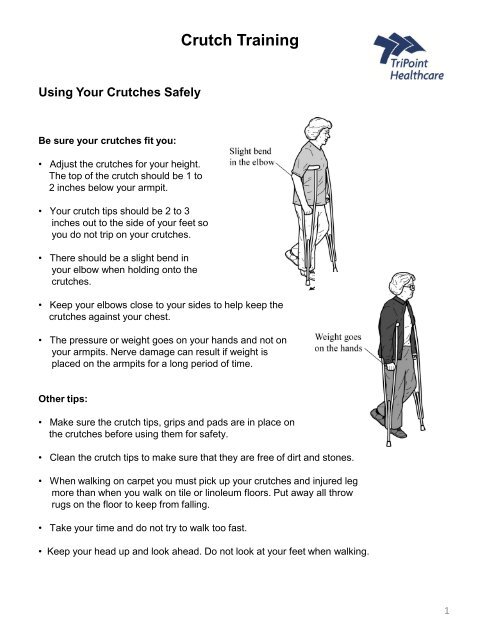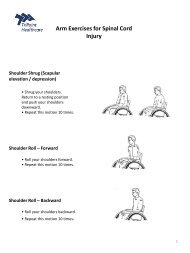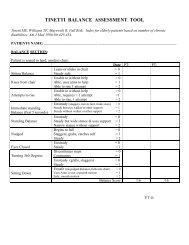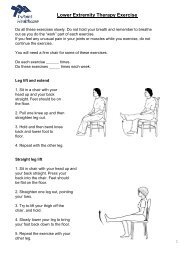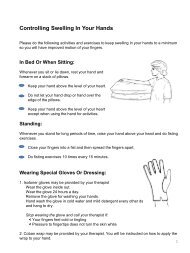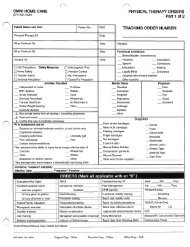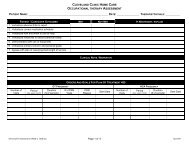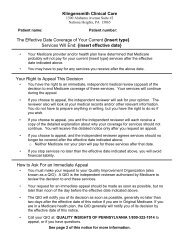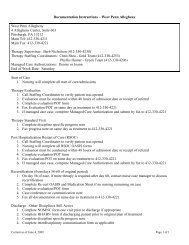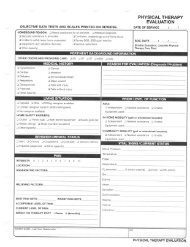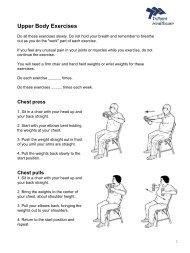Crutch Training.pdf - TriPoint Healthcare
Crutch Training.pdf - TriPoint Healthcare
Crutch Training.pdf - TriPoint Healthcare
- No tags were found...
Create successful ePaper yourself
Turn your PDF publications into a flip-book with our unique Google optimized e-Paper software.
<strong>Crutch</strong> <strong>Training</strong>Using Your <strong>Crutch</strong>es SafelyBe sure your crutches fit you:• Adjust the crutches for your height.The top of the crutch should be 1 to2 inches below your armpit.• Your crutch tips should be 2 to 3inches out to the side of your feet soyou do not trip on your crutches.• There should be a slight bend inyour elbow when holding onto thecrutches.• Keep your elbows close to your sides to help keep thecrutches against your chest.• The pressure or weight goes on your hands and not onyour armpits. Nerve damage can result if weight isplaced on the armpits for a long period of time.Other tips:• Make sure the crutch tips, grips and pads are in place onthe crutches before using them for safety.• Clean the crutch tips to make sure that they are free of dirt and stones.• When walking on carpet you must pick up your crutches and injured legmore than when you walk on tile or linoleum floors. Put away all throwrugs on the floor to keep from falling.• Take your time and do not try to walk too fast.• Keep your head up and look ahead. Do not look at your feet when walking.1
Weight BearingBased on your injury or surgery, you may need to limit the weight you puton your leg. Follow the order from your doctor or therapist:• Non-Weight BearingDo not let the foot of your injured leg touch the floor when standing or walking.• Touch Down Weight BearingTouch the ball of the foot of your injured leg on the ground to help your balance, but do not putweight on it.• Partial Weight BearingPut 30 to 50% of your body weight on your injured leg.• Weight Bearing as ToleratedPut as much weight on your leg as you can tolerate2
Standing UpPut both crutches on your injured side. Lean forwardand push off with your arm from the chair.Sitting DownRemove the crutches and place both of themtogether on your injured side. Hold onto the handgrips with one hand. Use your other hand to holdonto the arm rest or edge of the chair and slowly sitdown.StairsDo not attempt to climb stairs or curbs until you have complete confidence in using your crutches. For safetyreasons, you can sit down and scoot up and down the steps on your bottom if needed. If you have a rail, put bothcrutches under one arm and hold onto the rail for safety.Going up stairs with or without a railing:• Keep the crutches on the stair you arestanding.• Support your weight between your crutches.• Bring your good leg up to the next step.Let the injured leg trail behind.• Straighten your good leg and bringthe crutches and your injured leg up.Going down stairs:• Put the crutches on the lower step while putting your injured foot forward.• Support your weight between your crutches.• Move your good foot to the lower step.3
Getting Into and Out of a Car• Have someone open the door and move the seat back as far as they can.• Back up until you feel the edge of the seat. Grab the back rest with one hand and the hand gripsof the crutches with the other.• Tip your head to avoid bumping it. Stand up or sit down using your good leg to bear your weight.To sit down, put the heel of your good leg on the car frame and push back. Move across the seatuntil your injured leg can be swung into the car.4


